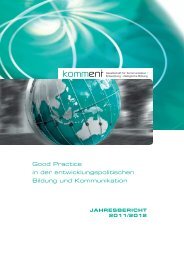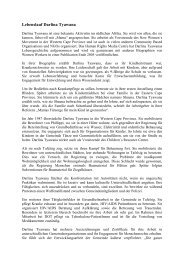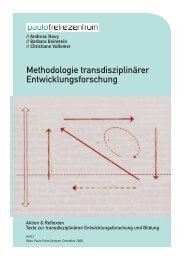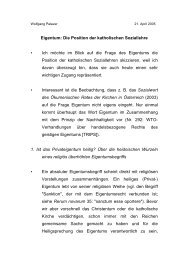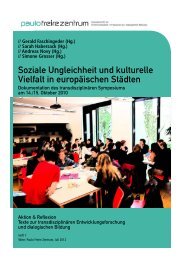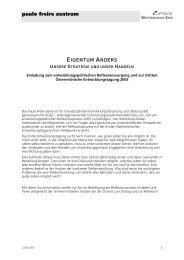Africa 2000 Network Uganda Initiatives
Africa 2000 Network Uganda Initiatives
Africa 2000 Network Uganda Initiatives
- No tags were found...
You also want an ePaper? Increase the reach of your titles
YUMPU automatically turns print PDFs into web optimized ePapers that Google loves.
<strong>Africa</strong> <strong>2000</strong> <strong>Network</strong><strong>Uganda</strong> <strong>Initiatives</strong>APresentation atThe 4 th Austrian Development Conference atInnsbruck, Austria 14 th to 16 th November 2008ByFrederick Musisi KabuyeExecutive Director, and East <strong>Africa</strong> RegionalRepresentative for Horizont 3000 Partners
A2N <strong>Uganda</strong> Vision• Improved andsustainablelivelihoods forthe smallholderhouseholds.
A2N <strong>Uganda</strong> Objectives• Promote the use of sustainable agriculturaltechnologies and practices in harnessingthe natural resources.• Build the capacities of smallholder farmersfor ecologically sustainable development.• Encourage active participation of men,women and youth of all capabilities indevelopment activities.
A2N <strong>Uganda</strong> Objectives Cont’d• Empower the local communities to ceaseopportunities for livelihood transformation,democratic leadership and goodgovernance.• Build local institutions for collective action inthe areas of marketing, resource mobilisationand advocacy.• Strengthen farmers’ entrepreneurial skills forsustainable income generation and povertyeradication.
A2N-<strong>Uganda</strong> Priority Area 1• Organizingsmallholderfarmers forcollective actiontowards householdfood security andincome generation
A2N-<strong>Uganda</strong> Priority Area 2• Genderintegration andnaturalresourcesregeneration andconservation
A2N-<strong>Uganda</strong> Priority Area 3• Dissemination ofappropriateproduction andproductivityenhancingtechnologies
A2N-<strong>Uganda</strong> Priority Area 4• Informationgeneration anddisseminationabout bestpractices andexperiences
A2N-<strong>Uganda</strong> Priority Area 5• Communityempowermentfor sustainabledevelopment andlivelihoodimprovementthrough creationof social capital
A2N-<strong>Uganda</strong> programme areas1.Natural Resource Management (NRM)2.Local Community Empowerment3.Market Access/ Marketing4.Information, Communication And <strong>Network</strong>ing5.Organizational Development andManagement
A2N <strong>Uganda</strong> strategic andspecific objectives for 2007-11• Natural Resources Management– Improving productivity, regeneration and conservationof Natural Resources for improved livelihoods in theproject areas.• Participants in the project undertake effective soil, water andland use management practices.• Energy and Environment Conservation practices enhancedamong the participating communities.• Smallholder farmers in the project areas practice sustainablecrop and livestock management for food security and incomegeneration.
Access to Markets• Small holder farmers facilitated to transform fromsubsistence to market oriented farming for foodsecurity and increased household income.– Enterprise development among the participatingcommunities based on participatory market research(PMR) and Participatory Market Chain Analysis(PMCA) interventions.– Participating communities adopt post harvesthandling and processing methods and technologies tomitigate losses and for value addition to theirproduce.– Participating communities access critical inputs,savings and credit services to boost their enterprisesdevelopment.
Local Community Empowerment• Local communities are well organised to attain Goodgovernance and actively participate in their owndevelopment initiatives using PDM methodology– Participating communities organiser themselves into viable localinstitution to promote their development initiatives at all levels.– Participating communities embrace civic education andundertake community advocacy to influence local governance.– Participating communities access development information andutilise the same to plan and make decisions about theirlivelihood transformation.– Participatory Development Management (PDM) methodologypiloted and popularised among the participating communitiesand local governments.
Information, Communication and<strong>Network</strong>ing• Communities utilising ICT to generate,document, and disseminate indigenousknowledge while accessing critical informationfor their development initiatives.– Participating communities facilitated to generate,document and disseminate information about theirdevelopment initiatives and experiences.– Critical linkages and alliances identified andestablished to create synergy for communitytransformation.– Info-centres established for reference and ICTutilisation by the communities in the project areas.
Outreach strategies• Integration of livelihood improvementinterventions• Mainstreaming of cross-cutting issues• Facilitating the emergency of strongfarmers organizations for collectiveaction• Innovations• Partnerships
A2N-<strong>Uganda</strong>Institutionalcapability• Track record• Human resource base– Board of Directors (BOD)– Professional Staff– Members– Volunteers• Management– Participatory Planning, Monitoring and Evaluation(PPM&E)– Transparent Reporting
Affiliations• <strong>Africa</strong> <strong>2000</strong> Regional <strong>Network</strong>• Development <strong>Network</strong> of Indigenous VoluntaryAssociations (DENIVA)• International Federation of Organic AgricultureMovement (IFOAM).• National Organic Agriculture Movement of <strong>Uganda</strong>(NOGAMU)• Participatory Ecological and Landuse Management(PELUM)• Promoting Local Innovations in Ecologically OrientedAgriculture and Natural Resource Management(PROLONNOVA)
• CIAT/BOKU University• International Centre forResearch on Agro-forestry(ICRAF)• International Centre for InsectPhysiology and Ecology -ICIPE Nairobi• Makerere UniversityFaculty of Agriculture• Ministry of Agriculture• National Agricultural ResearchOrganisation (NARO)• Local Governments• Sister NGOs in project areasCollaborators
Supporters of A2N-<strong>Uganda</strong>• CORDAID.• Farm <strong>Africa</strong>.• ADA through Horizont 3000.• Local Governments.• The McKnight Foundation.• UNDP.• Kilimo Trust (Gatsby Foundation)• Plan International, <strong>Uganda</strong>
Institutional Sustainability• Ecological Fruit Processing Initiative of<strong>Africa</strong> <strong>2000</strong> <strong>Network</strong>-<strong>Uganda</strong> for: -– Value addition to get higher incomes– Extension of shelf-life to mitigate postharvest losses– Offer additional income to A2N-<strong>Uganda</strong>towards own budget contribution whilesupporting farmers with a steady fair market– Best practices demonstration
Organizational setup• <strong>Africa</strong> <strong>2000</strong> <strong>Network</strong> –<strong>Uganda</strong> 100%ownership of theBusiness Company togenerate co-financingrevenue towards herdevelopment activitiesbudget supportSoleil EnterprisesLtd.Registered businesscompany (limited byshares)Ecological FruitProcessing (EFP)Project funded by theAustrian Government(ADA/Horizont3000)
Ecological Fruit Processing (EFP)– Project funded by theAustrian Government(ADA) April 2006 – March2008– Drying of pineapples,mangoes, apple bananas,papayas, and jackfruit withmodern hybriddryers (solar plus biomassbackup)– Intended to processorganic produce to tap intoEuropean niche markets
Fruit solar drying facility established– Achievements• Facility established• Equipment installed• „Lease title“ is beingpursued• 9 staff members employed– Challenges/lessons learnt• Delays in construction &delivery of equipment• Power supply• Quality standards andsteady markets25
Organic agriculture (OA) contributes to foodsecurity and poverty reduction in <strong>Uganda</strong>– Organic farmers in <strong>Uganda</strong> get a premium between 25% and 150% overfarm gate prices for conventional fresh produce– A study among farmers in <strong>Uganda</strong> found that• Organic farmers’ average net income consistentlyexceeded those of conventional farmers• Organic pineapple farmers produced significantlymore pineapples than conventional farmers;however, they sold a majority of their crop without apremium to conventional buyers*– Most <strong>Uganda</strong>n farmers are poor and marginalized from input and productmarkets → OA can improve food security by cheap, low-cost, locallyavailable technologies and inputs– Farmers’ testimonies confirmed that organic agriculture is a perfectlyviable system to address food security and poverty* Not because of labour, time or cash constraints, but their organic buyer was only interested in pineapples weighing1.2-1.6 kg which were only less than a quarter of all pineapples harvested26Source: Taylor 2006; Bolwig & Odeke 2007; Scialabba & Hattam 2002; NOGAMU
Small farmers still face many challenges to getorganically certified– Insufficient knowledge ofsustainable and organicagriculture– Management skills insufficient toestablish and implement anInternal Control System (ICS)– Governmental extension serviceinstitutions (i.e., NAADS) remaintoo conventional in theirapproach– High costs ofcertification/lacking creditfacilities to make such aninvestment– High level of trust andcooperation among farmersrequiredAs a result, most produce in<strong>Uganda</strong> is grown naturally, thoughonly a small fraction is certified.27
<strong>Uganda</strong>’s s organic sector started developing in 1994and has now its own inspection and certification body– In 1994 two projects gainedcertification (cotton, fruits &vegetables) and EPOPA* started tosupport organic exporters– In 2001 NOGAMU was founded –an umbrella organisation bringingtogether producers/farmers,processors, exporters, and otherstakeholders– UgoCert – the national organiccertification body – was registeredin 2004 (aiming at gettinginternationally accredited by theend of this year)– UgoCert developed their owncertification marks in 2006* Export Promotion of Organic Products from <strong>Africa</strong> (EPOPA) is a programme created by the Swedish InternationalDevelopment Cooperation Agency (Sida)28
Organic exports from <strong>Uganda</strong> are growing1.200,01.000,0800,0600,0400,0200,0-Certified organic exports by product (tons)<strong>2000</strong>/01 2001/02 2002/03 2003/04 2004/05Dried fruit 3,8 17,5 49,0 75,0 64,2Fresh fruit 256,6 500,0 650,0 800,0 1.080,0Cotton 262,0 480,0 681,0 750,0 856,0Sesame 590,0 340,0 474,0 800,0 1.100,0Coffee 301,2 86,4 150,0 109,7 120,0Vanilla 0,2 1,1 1,9Cocoa 84,0 160,0 180,0Dried fruitFresh fruitCottonSesameCoffeeVanillaCocoa• Stronggrowth ofmost certifieexportproducts• Dried fruitsexportsgrewbetween 50360% p.a.*• Total valueof exportsincreasedfrom 4.6M.USD (2002)to 10.3M.USD(2005)*** Except a decline in volume between 2003/04 and 2004/05** Annual average growth rate of 50%Source: NOGAMU29



